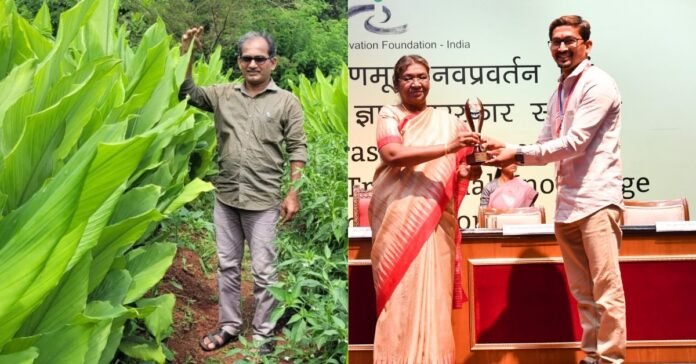
Turmeric isn’t just a spice—it’s a tradition, a medicine, and a staple in every Indian kitchen. But what if we told you there’s a new variety that could change the way we grow it? Meet SK-4, the high-yielding, disease-resistant turmeric variety developed by a farmer, for farmers.
Sachin Kamlakar Karekar, a 48-year-old farmer from the lush fields of Abloli village in Maharashtra’s Ratnagiri district, has done something incredible. With a keen eye and relentless determination, he has developed SK-4, a turmeric variety that’s now being grown by over 500 farmers across Ratnagiri, Sindhudurg, and Raigad. His passion and innovation even earned him a prestigious award from President Draupadi Murmu at the 11th Biennial National Grassroots Innovation and Outstanding Traditional Knowledge Awards.
A Journey from Tradition to Innovation
India is the world’s largest producer, consumer, and exporter of turmeric, with 11.61 lakh tonnes harvested in 2022-23. In Maharashtra, the Rajapuri Salem variety has long dominated, contributing 70% of the state’s production. But Karekar saw an opportunity to improve things for farmers like him.
It all started back in 1998, when Karekar planted the local Kadja variety. Among his crops, he noticed a few standout plants—early maturing, vibrant in color, disease-free, and with bigger rhizomes. He didn’t just observe; he experimented. Year after year, he carefully selected the best plants, improving them little by little. By 2008, he had created SK-4—a variety with superior traits that could change the turmeric industry. The name? A heartfelt tribute to Shendge Kaka (the farmer who initially gave him Sangli Kadapa tubers), Special Konkan, and, of course, his own initials.
Scientific Backing and Farmer Approval
In 2020, the Dapoli-based Dr. Balasaheb Sawant Konkan Krishi Vidyapeeth (DBSKKV), along with the National Innovation Foundation (NIF), tested SK-4’s performance. The results? Outstanding. SK-4 produced a yield of 56 tonnes per hectare, making it one of the top-performing turmeric varieties, second only to the best check variety, Sona (64t/ha).
Dr. Prafulla Mali, a horticulturist at DBSKKV, is optimistic about SK-4’s future. “This variety is a blessing for farmers in high-rainfall areas like Konkan. It performs exceptionally well, and we believe it can fill the gap where seed shortages of premium varieties like Rajendra Sona exist.”
What Makes SK-4 Special?
- Higher Curcumin Content: SK-4 boasts a curcumin content of 4%, compared to the widely grown Rajapuri Salem variety’s 3.5%. That means richer color and greater medicinal value.
- Disease Resistance & High Yield: It’s resistant to rhizome rot (karpa) and matures in just 160-170 days.
- Bigger, Brighter Rhizomes: Perfect for culinary and medicinal uses, making it a valuable crop for farmers.
How Farmers Are Growing SK-4
Many farmers have already adopted SK-4, and their results are astonishing. Vishram Mali from Velamb village harvested a whopping 8.15 kg of turmeric from a single sapling!
The secret? A structured cultivation approach:
- April: Rhizomes are planted in nursery bags.
- June: Saplings are transplanted into fields enriched with organic fertilizers.
- August: The plants receive a second round of water-soluble fertilizers.
- January: Irrigation continues until the plants reach maturity.
- February: Harvest time! Each sapling yields an impressive 3.2 kg or more.
Farmer Gajendra Paunikar, a former Agriculture Extension Officer, swears by this method. “Planting rhizomes in nursery bags rather than directly in the field gives a 90% success rate. It’s a game-changer.”
A Growing Movement Across India
SK-4 is now being cultivated in 13 states. Farmers from Nandurbar, Vidarbha, and beyond are eager to get their hands on this variety. At a recent NIF event in Rashtrapati Bhavan, farmers from across the country bought SK-4 tubers to try in their own fields.
Karekar’s hard work was officially recognized last December when the Protection of Plant Varieties & Farmers Rights Authority (PPV&FRA) granted him breeder status. That means he has exclusive rights to produce and sell SK-4 for six years—an achievement he never imagined when he first started this journey.
Advice for Aspiring Turmeric Farmers
Karekar has a word of wisdom for those looking to grow turmeric: Start small.
“I began with just one guntha (1,000 sq. ft.), and now I have 10 gunthas with 3,000 saplings. Don’t rush into large-scale farming—learn, observe, and grow steadily.”
He also runs an agritourism project on his two-acre farm, where visitors, especially bird watchers, get to experience sustainable farming up close.
With its high yield, resilience, and superior quality, SK-4 is set to revolutionize turmeric farming in India. As more farmers adopt this variety, it’s only a matter of time before SK-4 becomes the new gold standard in turmeric cultivation. The best part? It all started with one farmer’s passion for making a difference.

